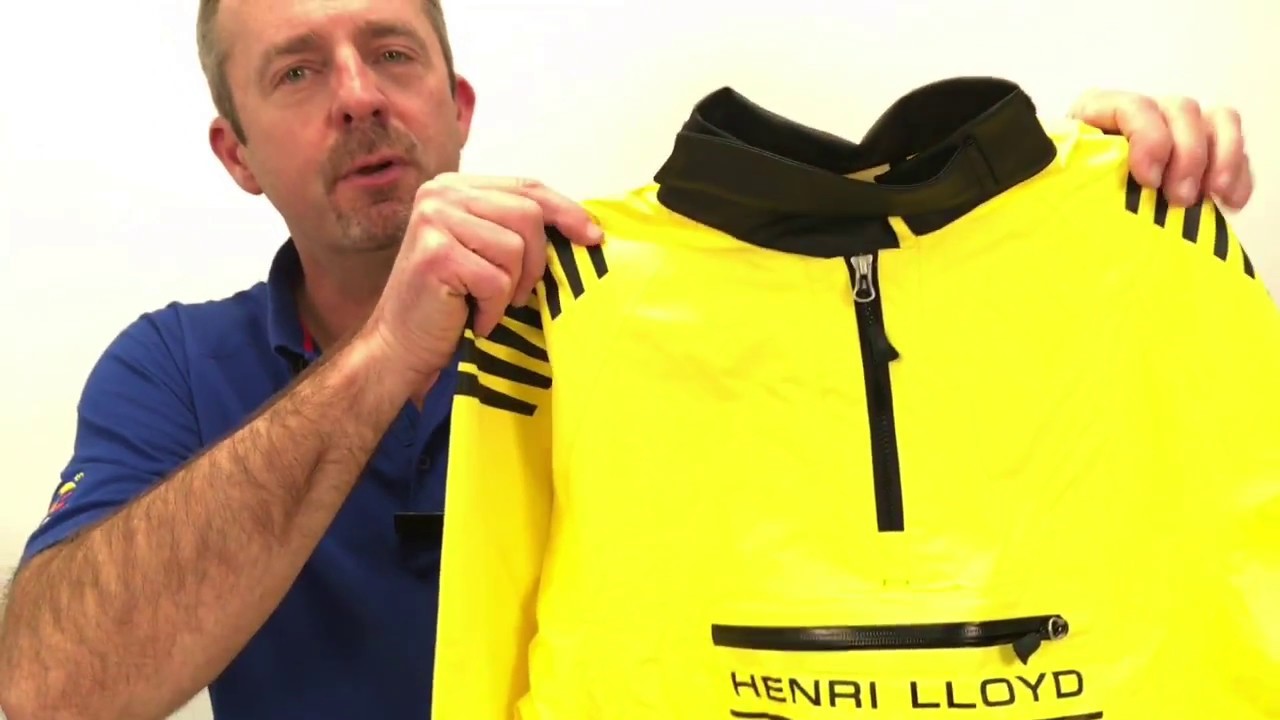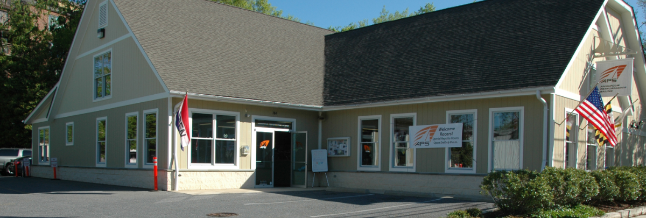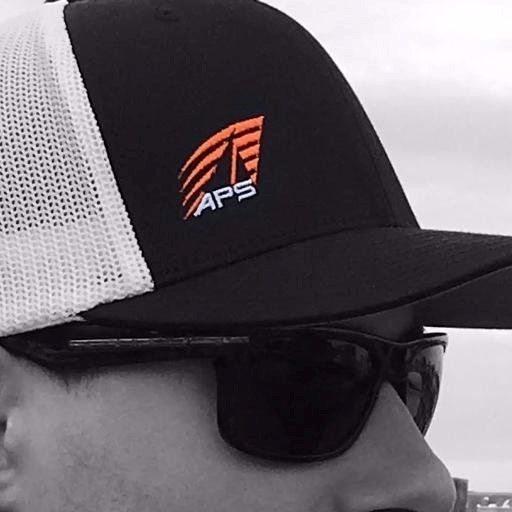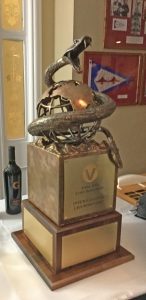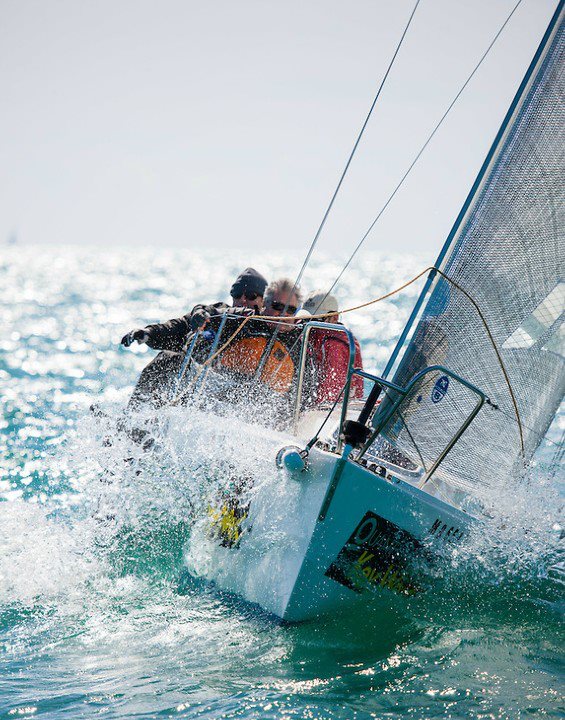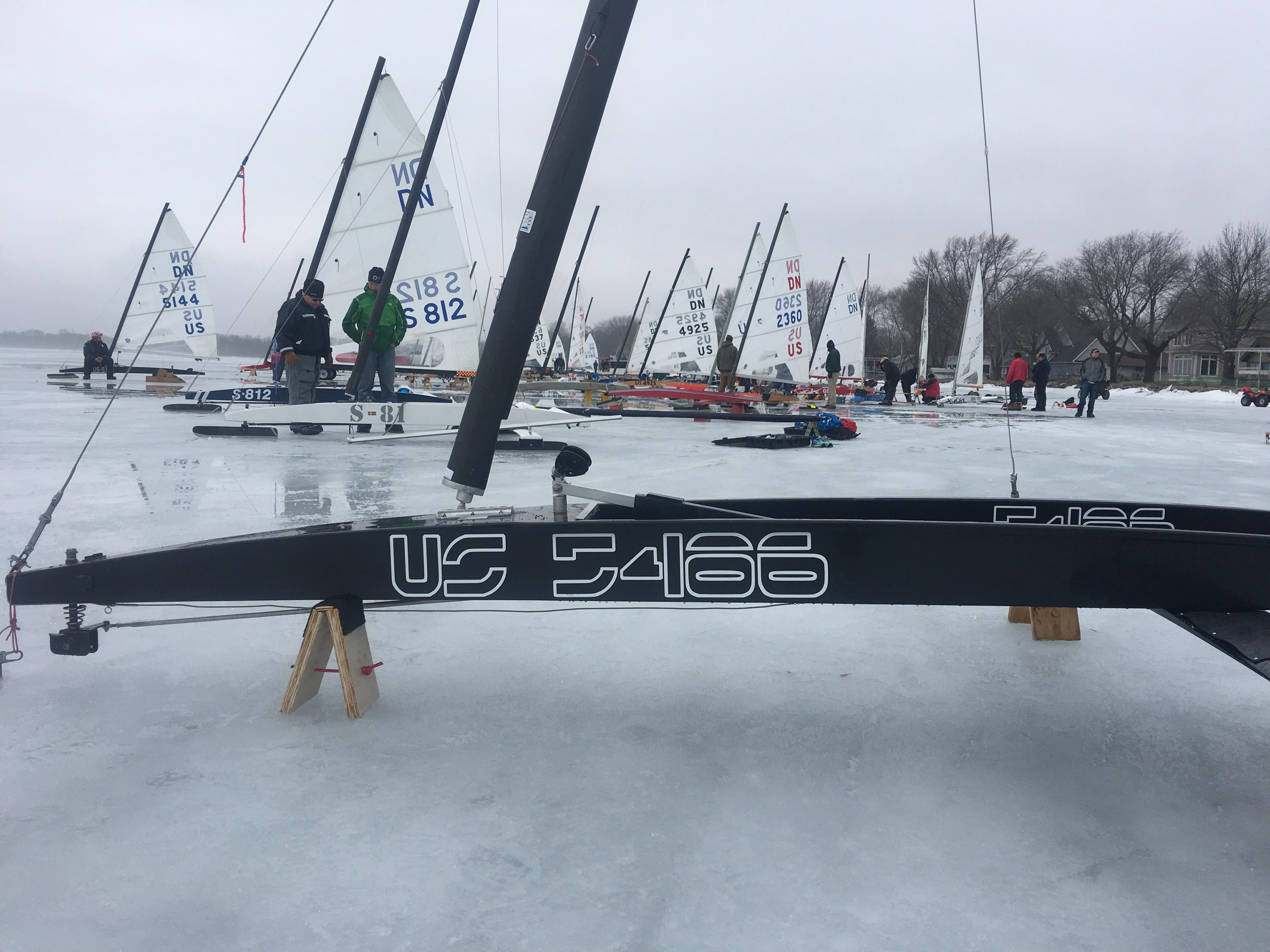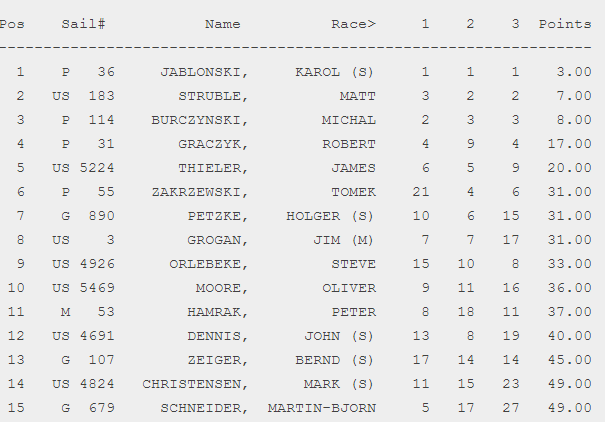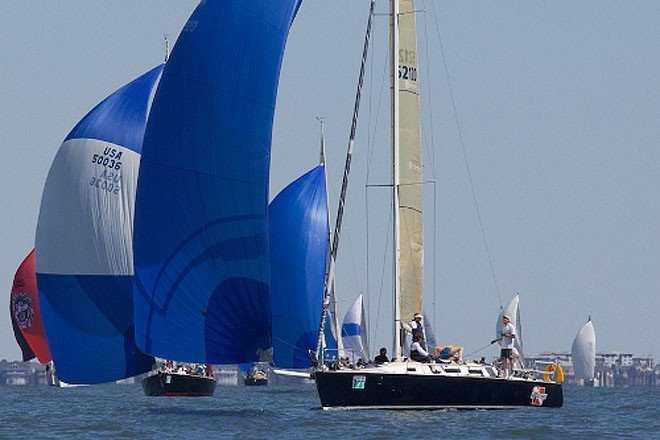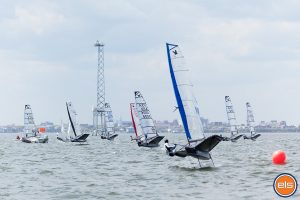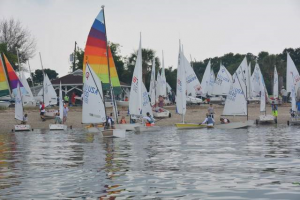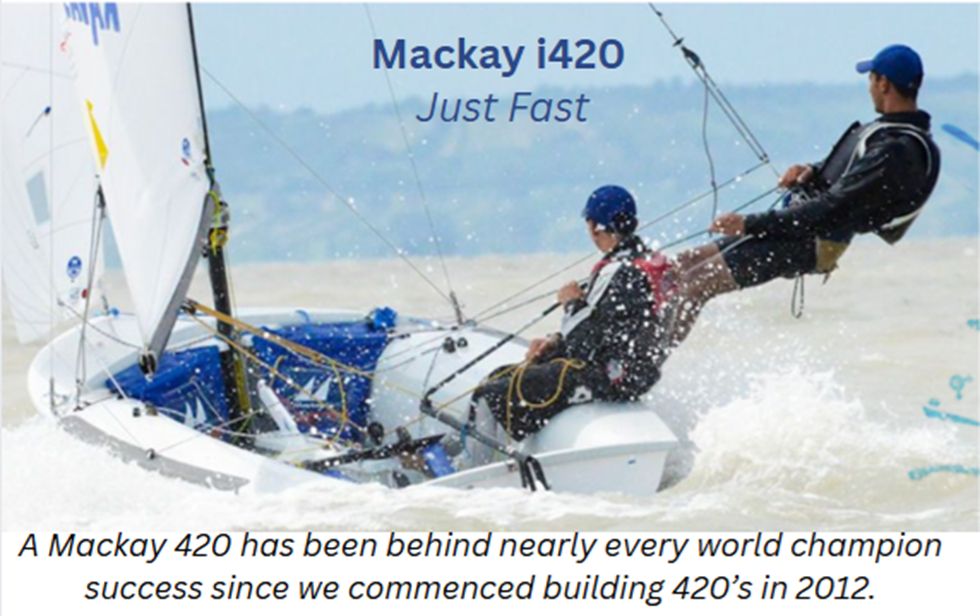By Airwaves Writer Taylor Penwell
Known to those in the sailing world as APS, Annapolis Performance Sailing is the capital sailing store in the United States that does business around the globe. The core values held close have been to stock a wide selection of products 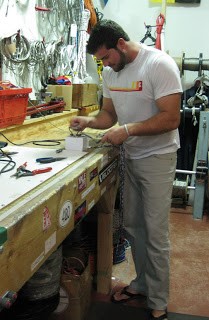

Original APS Store
With a clear strategy, lots of slog, a small bank loan, and help from his employer and friends, he opened the first location in Eastport, an area adjacent to the Chesapeake Bay, in the historic city of Annapolis, Maryland.
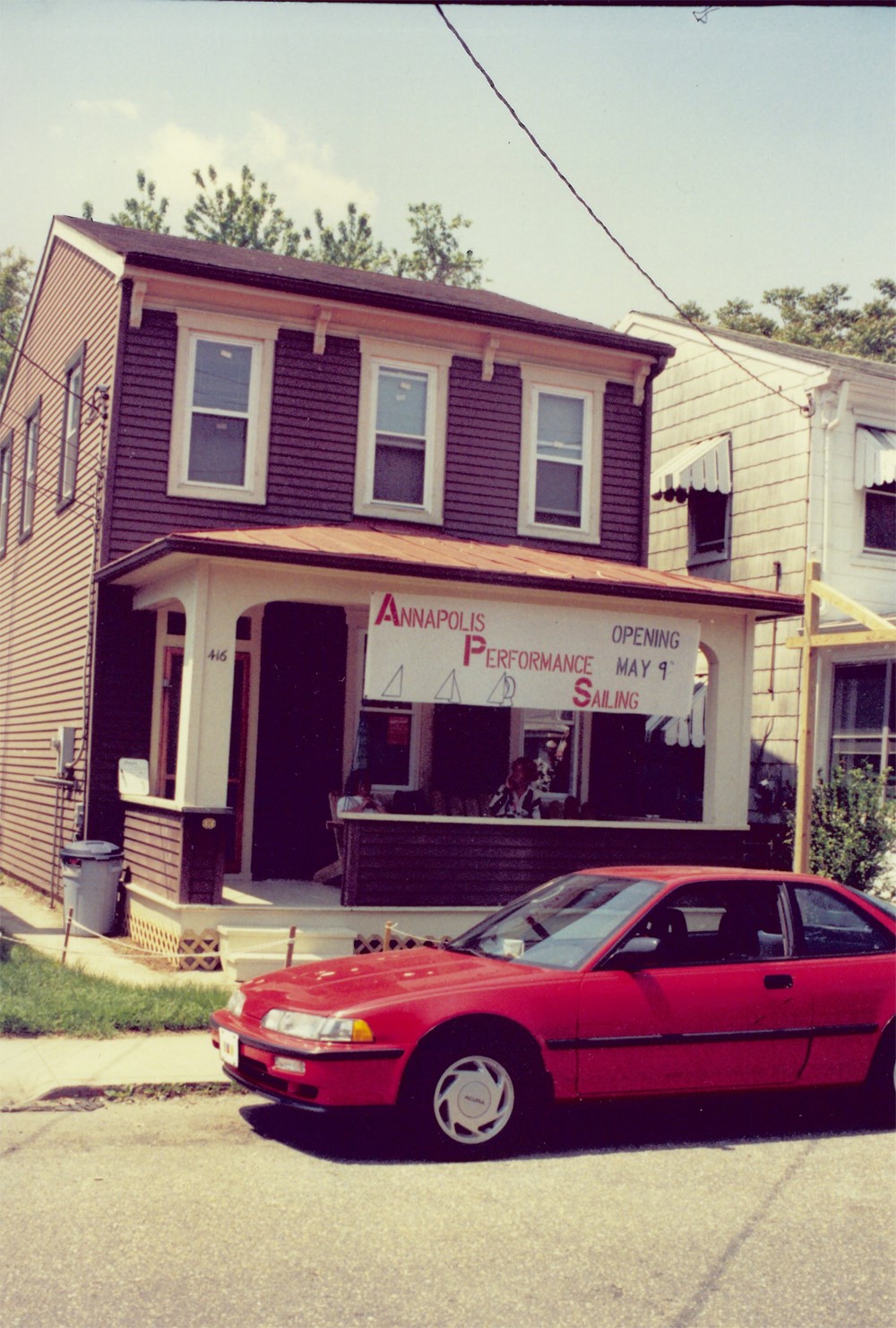
In 1992, Kyle decided to produce a mail order catalog to bridge the gap between sailing locations and connect with customers nationwide and around the world.
APS Founder and President Kyle Gross
With technology being far from what it is today, the product photos were taken, trips to a photo shop to turn film into half tones were made, and actual cutting and pasting was the method for creating the catalog. Friends helped by modeling for apparel photos and were enticed with beers and pizza to stick address labels on finished catalogs. The initial circulation was around 3000.
The APS catalog grew in size and distribution year after year establishing APS as a serious mail order company. The addition of a dedicated and knowledgeable call center team increased customer service, further helping the company grow into an international presence.
APS catalogs were expanded to over 100 pages, full color with a distribution in excess of 100,000. The retail space increased in size twice, the APS website was launched, the rigging department was created and the product offering became much larger.
In 2003, Kyle designed and built the current 6000 square foot APS storefront and fulfillment center. Since then, our product offering has been expanded beyond 15,000 items, staff size increased and the Crugear department for decorating team gear was added.
APS Current Store
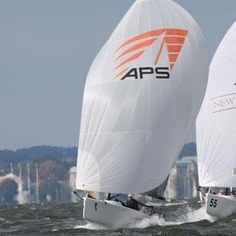
APS continues to change, adapt and thrive as a sailing retailer in the digital age. In 2015 a new enterprise website was launched to further improve the customer shopping experience and the APS Advisor was introduced as the source for sailors to access the knowledge and information that is the hallmark of APS and its employees. The Advisor houses the hundreds of videos, articles and photographs developed by the APS team in-house. Be sure to check out Advisor for all your sailing needs and questions.
http://www.apsltd.com/aps-advisor/
Nothing represents the stores metamorphosis over these past 25 years than the catalog covers. They clearly show the evolution of a company that started out in dinghies, moved to keelboats, was an early adopter of online retail focusing effort exclusively on sailing rather than boating and water activities in general, and will continue to provide the widest selection of quality sailing specific products and services for apparel, line, hardware, and rigging at competitive prices.
For all your sailing and racing needs APS is the store that is two legs ahead of the competition. Their friendly staff members can help you with your order over the phone, in their new websites online chat, and of course in person in the storefront.
Follow this link to check them out online,
http://www.apsltd.com/
A special thanks to APS Create Content Function Owner and friend Claire Davidson Yoste, and President Kyle Gross for supplying the information for this article.
APS is located at 104 Severn Avenue in Annapolis, MD. We can be reached at 800.729.9767 during business hours: 9:00am – 5:00pm US EST, Monday – Friday. Our Sales & Customer Service Center is closed on Saturday and Sunday – you can reach us by email by clicking here. Our storefront is open on the weekends from 8:00am – 5:00pm EST for walk in customers.
Herreshoff 12 1/2 "H Class"
H Class Association
The Herreshoff 12½ footer was designed in 1914 by Nathanael G. Herreshoff, and the first boats were launched in Buzzards Bay in 1915. Way back then, no one could have foreseen the cultish popularity and longevity of his design — which has remained unchanged for more than 100 years! She is widely considered to be one of the finest, if not the finest, small sailing yacht designs ever created.
The H Class Association hosts an annual regatta each summer, with between 30-40 boats participating. In addition there are very active racing fleets in the Buzzards Bay area (Marion, Quissett, Wing’s Neck) as well as on Martha’s Vineyard (Edgartown and Menemsha), and Shelter Island, New York. There are fleets all throughout Maine, down to Annapolis, and one in Saudi Arabia.
Please visit the H Class website for more information: http://www.herreshoff12.org
International Viper 640 Class Becomes the Newest World Sailing Class Crowning First Viper World Champions
February 21, 2017 For Immediate Release
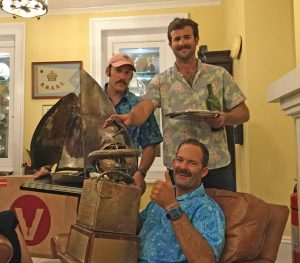
Commenting on the completion of this process, Viper 640 Class International Chairman Justin Scott said, “We have fleets in three continents and a circuit of destination regattas over the next three years that span spectacular locations across North America, Australia and Europe. The Viper 640 is now truly an international one-design class.” Jason Smithwick, World Sailing’s Director of Technical and Offshore, added, “The Viper 640 combines an excellent boat and a solid international organization with great sailors that enjoy each other’s company both on the water and off. We are delighted to have the Viper 640 class join the World Sailing family.”
Perth 2018 – World Championship
The International Viper 640 Class is pleased to announce its next World Championship Regatta from February 17 to February 23 2018 at South of Perth Yacht Club, Western Australia. SoPYC is one of the largest yacht clubs in Australia with more the 2,300 members and truly magnificent world class facilities. They have hosted several national championships, they co-hosted the World Sailing Team Racing World Championships in 2009 and the Sailing World Championship in 2011.
February will provide ideal sailing conditions on the Swan River estuary with the infamous southwesterly “Doctor” blowing in the afternoon from 15–25 knots.
Viper 640 Australian Class president Graeme Monkhouse stated, “We are aiming to host the largest Viper regatta ever outside of North America with 20 Western Australian Vipers eager to go up against some of the best Viper sailors coming in from around the World.”
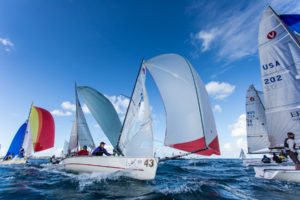
The Class is also announcing that , Alamitos Bay Yacht Club, Long Beach, CA, USA, will host the 2019 Viper 640 World Championship. Alamitos Bay Yacht Club Commodore Chuck Clay said, “We’ll make sure Viper sailors have spectacular racing on the water while enjoying our special southern California hospitality ashore.”
For more information contact Viper 640 Class Association Administrator Ed “Buttons” Padin ([email protected]) or Rondar Raceboats, the Class builder (www.rondarboats.com)
2017 Club 420 Midwinters Results & Report
February 18-20, 2017 Results at: http://www.club420.org
Jensen Beach, FL – A 103 boat fleet was treated to a spectacular weekend of racing that saw conditions that delivered each day and certainly kept the competitors on their toes from shifty light conditions to full trapeze planning conditions, we had it all. The regatta format was two days of a qualifying round, where the fleet was divided into two fleets and seeded by a formula. The final day was a medal round where the top 52 boats were in gold and sail for the championship and the next 51 boats sailed in silver.
The regatta was close all the way through with Jack Johansson and Jack DeNatale from “Team Chill” showing off some commanding speed at times leading the regatta through the qualifying round with their worst score as a 2. On the second day of racing Jack and Jack swept the day with all firsts. Not to be out done Tucker Weed and Olivia de Olazarra stayed tight with the Jacks by scoring no lower than a 3 and staying extremely consistent through the qualifying round and setting up a show down with Jack and Jack on the last day trailing by just 4 points. Ivan Shestopalov and Claudia Loiacono stood in third after the qualifying round 10 points back of Tucker and Olivia and in a tight battle with local hero’s Emily and Katie Bornarth from the USSC Martin County.
On the Final day Tucker Weed and Olivia de Olazarra from Coral Reef Yacht Club showed their mental toughness and overcame the deficit to beat Jack Johansson and Jack DeNatale to win the 2017 Midwinter championship. The local ladies Katie and Emily Bornarth also battled today finishing 3rd overall. It was a fantastic weekend of racing with 11 races in Gold and 10 races in silver fleet. The PRO Campbell Rich and his team did a fantastic job keeping the racing going and keeping it fair in sometimes tough conditions. The class thanks Alan Jenkinson and his incredible group of volunteers for another great Midwinter championship in Martin County, we look forward to next year!
Top 5- Gold Fleet
Tucker Weed/ Olivia de Olazarra 18pts.
Jack Johansson/ Jack DeNatale 22pts.
Emily Bornarth/ Katie Bornarth 50pts.
Jack Reiter/ Tanner Chapko 54pts.
Boyd Bragg/Aisling Sullivan 61pts.
Top Junior Boat
Luke Arnone/ Mariner Fagan
About The Club 420 Class Association
The Club 420 Association was established in 1980 to promote, foster, encourage and sponsor one-design sailing. The Association sponsors a class North American Championship, US and Canadian National Championships as well as regional championships for the class across North America while promoting the class to all ability and experience levels of youth sailing. Since 2006, the class membership has more than doubled from 300 to its current 715 members. The class offers many regional, national and North American championships in both fleet and team racing formats as well as clinics across North America. Our Nationals / North Americans have had 175 boats attend, with all levels of sailors competing in some of the finest and socially fun regattas you will attend.
About The Club 420
The Club 420 is a two person dingy which forms the base of many local, high school and collegiate programs in North America. Simple for beginning sailors and yet challenging enough for collegiate champions. The Club 420 offers more learning opportunities than any other double-handed boat you can find. Over 5,000 Club 420s are sailed in youth, high school and collegiate programs all over the United States, Canada, Mexico and the Caribbean.
For more information please visit our website at www.club420.org or visit us on Facebook
Contact:
John Vandemoer, Executive Director
Email – [email protected]
2017 ICSA Team Race Preview & Coaches Poll
2017 ICSA Team Race Preview & Coaches Poll, 21 FEB 2017
By Airwaves Writer Dillon Paiva
Brought to you by Dynamic Dollies, Sail1Design would like to welcome everyone to the spring team race season! This discipline in college sailing is growing more popular every year. Sailors love the short course, fast pace, expert boat handling required, and of course, team work. Before the first collegiate team race regattas of the season begin this weekend, Sail1Design brings you this exclusive in depth look at the best teams in the country. We reached out to five college coaches and asked them to rank the top ten teams in the ICSA, and then give us some comments on each team. Below are the pre-season tabulations. See the full rankings and coaches comments HERE
| Rank | School | Total Points |
| 1 | Yale | 50 |
| 2 | BC | 44 |
| 3 | Georgetown | 41 |
| 4 | Dartmouth | 34 |
| 5 | Navy | 19 |
| 6 | Charleston | 18 |
| 7 | Stanford | 12 |
| 8 | MIT | 10 |
| 9 | St. Mary’s | 7 |
| 10 | Hobart | 6 |
| Also receiving votes: Roger Williams, Tufts, Bowdoin | ||
About Sail1Design
Sail1Design is a grassroots organization, by sailors for sailors, dedicated to the youth, high school, college, and one-design sailing communities. Born in 2007, Sail1Design has grown considerably, and reaches out to all sailors wishing to enjoy and learn more about our sport. We have three main areas of business:
SAILING/MARINE INDUSTRY CAREER CENTER & JOB BOARD
We offer sailing’s #1 Career Center and Job Board, always chock full of incredible sailing job opportunities. Our comprehensive career center also offers job seekers the ability to create their own web page, highlighting their experience and posting their resume. Likewise, employers can search our resume database to find the right match for that open position. Sail1Design is proud also to be the official job board of the Intercollegiate Sailing Association (ICSA), the US High School Sailing Association (ISSA), and US Sailing.
MARKETPLACE & PROFESSIONAL BROKERAGE
Unique to the industry, Sail1Design hosts and manages an active private, by-owner marketplace, focusing on performance and one-design sailboats & gear. For all boats under 25′, our ads are free. What makes us different is that we also provide, side-by-side, professional brokerage services as well. We have had great success helping our sailing clients market and sell their boats, using our powerful client base, social media, and the brokerage industries multiple listing service to ensure your boat gets noticed.
AIRWAVES NEWS & CALENDAR
S1D also hosts Airwaves, an interactive, user fed Sailing Calendar and informative Sailing News, Articles, tips, & more. Airwaves has developed a great niche in the sailing publication world, and now boasts a seven-member staff of dedicated sailors, all contributing to our varied content.
Waszp
Looking for a new boat, and not only a new boat but a foiling boat? A boat that is fast, fun, durable, and affordable? The Waszp may just be it! Similar to the Moth the Waszp offers sailors with a more durable and affordable boat. Just recently at the end of January, the first Waszp regatta took place in the US. This regatta was part of the Winter Series that the Moth class has held at the Upper Keys Sailing Club for the past couple years. Since the US Waszp class is brand new the president of the US Waszp class Reed Baldridge thought this winter series would be a great stepping stone for the class. The regatta brought 8 sailors with Waszp’s all around the country, it was not only a great regatta but a great learning and brainstorming session for this new class.

The Waszp is a one design foiler, that was created by Andrew McDougall, designer of the world beating Mach 2 foiling Moth. Recently, it was just named 2017 Best One-Design by Sailing Worlds Boat of the Year Awards. The Waszp and the Moth are similar in their concepts, but for a couple reasons, the Waszp hits a market of different dinghy sailors. First, the Waszp is half the price of the Moth, you can buy a brand new Waszp in the US for $12,500. Unlike the Moth the Waszp is a one design class. With the Waszp you have adjustable wing angles allowing you to adjust for your skill and for storage. The Waszp comes with retractable alloy foils making it an easy boat to launch. With a free standing rig, you can rig up quickly and have a much 
Strategy & Tactics in Waves
By Andrew Kerr
Having recently sailed a 10 race series at Key West Race Week that featured a large part of the regatta with waves and cluster chop. Here is some strategy, tactics and boat handling key elements that can help your team sail a fast and consistent series when the waves are up.
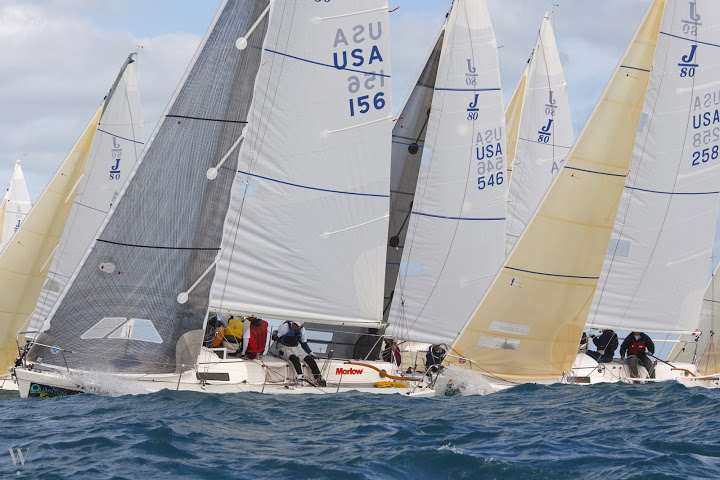
Which tack is better versus the waves and is there flatter water on the course?
Go upwind on each tack and get a feel for the wave formations and find out which tack is better versus the waves if there is one, very often they are similar.
Do we need to set the boat up differently from tack to tack?
On the harder tack we have found it better to move the lead one hole forward and ease the Jib/ Genoa and mainsheet slightly to sail the boat more open on the leeches to cope with the waves and the rapidly changing apparent wind angles.
On the easier tack the Jib / Genoa lead is typically a hole further back and the sheets trimmed on a little harder as it is easier to point in the flatter water.
Is there flatter water inshore?
At a lot of venues the waves are smaller inshore – research this when you go upwind in the pre-race period.
Communication
Take time to get the communication flowing from the wave caller in the crucial pre-race upwind leg leading up to the start – if it is constant waves then we have found it is even more critical for the wave caller to call out any flatter water so we can shift gears accordingly – “Flatter water in 3, 2, 1 – now – lasts for 2 boat lengths “is a really important piece of info.
Also be sure to work on identifying flatter spot’s to tack in, “flat spot to tack in 3, 2, and 1 – now “.
Boat speed wise, if possible we would like to get on on the easier tack so we can get off the line and find our space and go – the driver will appreciate this if you can choreograph it that way!
Which jibe is better or more stable downwind versus the waves?
As an example – at Key West we found the wave axis to be better on starboard tack as the boat could plane more consistently.
In the absence of wind and angle considerations – the better Jibe with the wave axis is going to get us going faster or if the wind is lighter and the waves more confused – will keep the boat more stable , is one better than the other? Very often the most challenging conditions are when it is light air with confused waves – is one jibe better than the other for keeping the spinnaker stabilized?
Starting
In decent sized waves it’s really important to get the biggest gap to leeward on the line that you can so that you can go bow down and full speed as long as possible without a leeward boat playing interference .
So strategically we are looking for a low density area on the line, away from crowds and in a place to sail to flatter water on the course or the favored side which at quite a lot of venues is inshore.
Upwind
- Try to sail on the easier tack as long as you can to get best VMG.
- Minimize tacks as much as you can as the loss from tacking can be substantial – be selective when you tack .
- To this end either tack in a flatter spot or if one is not available tack on the top of a wave so you minimize the loss.
- If lee bowing another competitor the adage is that in order to lee bow someone in waves you have to basically be able to cross them as the boat loses a lot of speed and you risk getting rolled over.
- If a lee bow will not work then either duck them for freedom to go fast or tack well early to maintain space and speed, remember the big picture of which side of the course you want and get the dialogue onboard going early .
- If looking for a lane of clear wind – be sure to pick a wide lane so that you can go fast without fear of falling into a boat that is pinching.
- Avoid packs of boats – they are usually sailing a little high and not optimum VMG, go for space.
- Lay lines to the weather mark should be called with a wider tacking angle in mind and slightly over standing is always going to be better than a tight lay line.
Downwind
- In the absence of velocity, current or angle considerations ( which may well be of higher priority ) then take the better jibe versus the waves – either to get the boat going faster and planning/ surfing more consistently or the one which is more stable if the waves are confused .
Leeward Rounding
- If it is planing / surfing conditions then err on the side of taking the spinnaker down a little earlier rather than later so you do not plane past the mark!
- If the wave is picking the boat up and pushing it downwind , be sure to turn the boat early upwind and trim the main in rapidly otherwise you will get pushed to leeward of the mark – sometimes a long, long
- If the waves are confused and slowing the boat down then fly the spinnaker as long as you can into the mark ( practice is key here ) for max speed in and out of the rounding.
- For all the above elements practice and repetition of takedowns and mark Roundings is going to be critical so you can make an informed decision on how long it takes to execute the boat handling and the rounding.
Best of luck in your next race or regatta and May the waves be with you!
Club Profile: Lakewood Yacht Club
News Flash: Lakewood Yacht Club is hiring a full-time Youth Sailing Director


Lakewood has a strong agenda of regattas and cruises organized by Lakewood’s enthusiastic volunteers. An active Ladies Association holds monthly luncheon meetings with a program in addition to a fun group trip every year. Our Youth Program, known as the Seahorses, is recognized as the best in Texas and is guided year-round by the club’s parent volunteers and dedicated coaches. Three lighted tennis courts and friendly but competitive monthly tennis socials and weekly matches add to the allure of Lakewood.
Lakewood Yacht Club offers a unique Youth Sailing Program, with a wide variety of opportunities for children of all ages. Achieving prominence as one of the top yacht club programs in the United States, our youth sailors (the Seahorses) participate in the Texas Sailing Association Series as well as National and International Regattas worldwide. With programs that offer year-round fun for members and guests alike, with our summer sailing camps, Learn-to Sail and Advanced Racing classes there is something for every young aspiring sailor at Lakewood Yacht Club.
Youth Sailing
Under the direction of dedicated coaches, Lakewood Yacht Club’s Youth Sailing Program has grown into being the envy of other yacht clubs all over the country, not just around the Gulf Coast. The Seahorses have brought stellar recognition to the club, influencing our membership growth as families join the club so their children can learn to sail and compete, if they wish. As long-time local racer Charles Milby says of sailing as a child,“Once I learned how to crew, once I learned how to trim a spinnaker and a jib, I could go anyplace. It was a skill I learned. I could sail a 13 foot boat or a sixty foot boat; the principles are exactly the same.”
News Flash: Lakewood Yacht Club is hiring a full-time Youth Sailing Director
J-Boats to Hold First U.S. J/70 Youth Championship
Win a FREE J/70 for your Sailing Club!

Interest has been strong from various youth teams across the country; with crews already gearing up for the J/70 Midwinters in St Petersburg, FL, hosted by St Petersburg YC and also the Helly Hansen San Diego NOOD Regatta, hosted by San Diego YC in San Diego, CA.
The goal of this event is to help develop and build leading-edge junior keelboat sailing programs across America. The winning club of this event will get “free” usage of a fully equipped International J/70 one-design class sailboat, with sails and trailer, provided “free of charge” by J/Boats, to the winning sailing club and its membership for twelve months.
The U.S. J/70 Youth Championship (USJYC) is open to eleven (11) Youth Teams representing US Sailing recognized Sailing Clubs or Organizations. Sailing clubs may enter more than one youth team per event, but may only qualify one team for the USJYC championship in Newport, RI.
The 11 Youth Teams will compete on eleven brand new J/70 Class sailboats with class sails (main, jib, spinnaker) that comply with J/70 Class rules. The boats will be identically rigged and tuned at “base settings” that are recommended by the sailmaker.
In order to qualify for the eleven slots, youth teams must qualify for entry by being the top scoring Youth Team in the J/70 Class at one of the following Regattas:
- Feb 24-26 J/70 Midwinters- St. Petersburg, FL
- Mar 09-11 Bacardi Miami Sailing Week- Miami, FL
- Mar 17-19 Helly Hansen San Diego NOOD- San Diego, CA
- Apr 20-23 Sperry Charleston Race Week- Charleston, SC
- May 05-07 Helly Hansen Annapolis NOOD- Annapolis, MD
- Jun 03-04 Cedar Point One-Design Regatta- Cedar Pt, CT
- Jun 09-11 Helly Hansen Chicago NOOD- Chicago, IL
- Jun 16-18 J/70 Great Lakes- Cleveland, OH
- Jul 07-09 The Newport Regatta- Newport, RI
- Jul 15-16 St. Francis Sportboat Regatta- San Francisco, CA
- Jul 27-30 Helly Hansen Marblehead NOOD- Marblehead, MA
Here is the USJYC Notice of Race. For more U.S. J/70 Youth Championship information, please contact J/Boats at “[email protected]” or refer to the website- http://www.jboats.com/j70-youth-championship
The Religion Known as Frostbiting
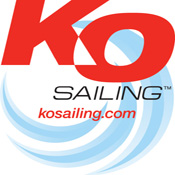
By Airwaves High School Reporter Paige Hoffman
Frostbiting: Are you up for the challenge? With about another month left of off-season before high school sailing gets started up in the Northeast, some of just can’t wait to get back on the water. Luckily for New England sailors, there are countless options for winter sailing for those of up that are up for it. Unfortunately, I have not able to try my hand at any frostbiting this year because I came down with pneumonia, but I was able to learn a lot about it by researching clubs in my area.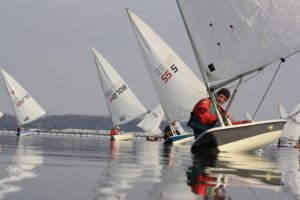
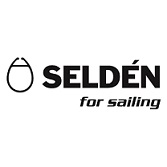
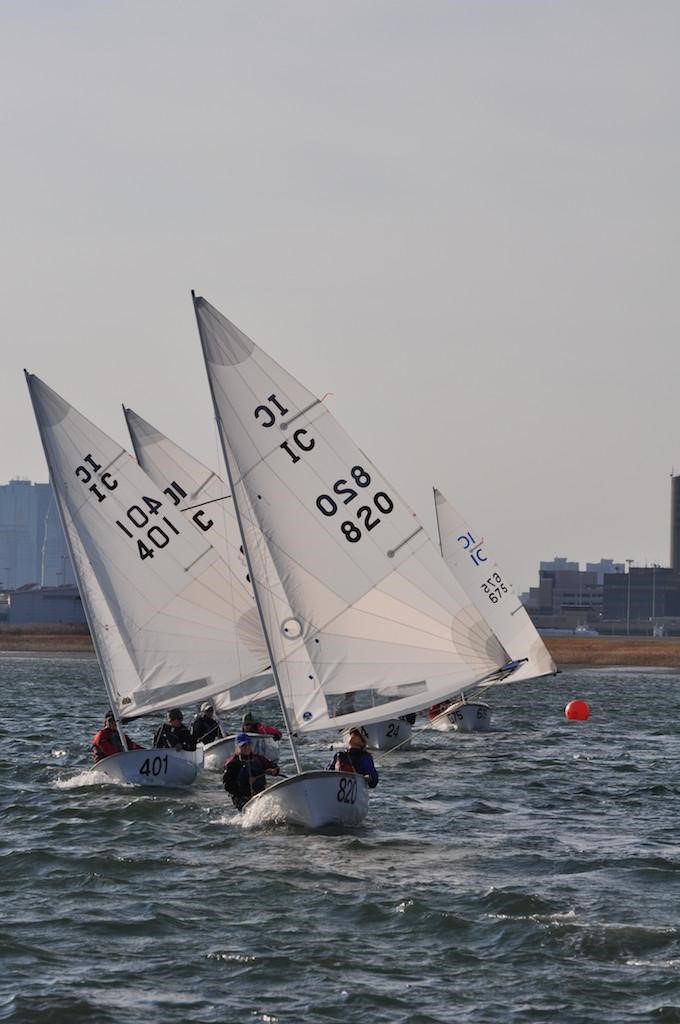
Bristol Yacht Club in Bristol, Rhode Island, also offers a good deal for junior sailors, frostbiting and storage of boats, which is offered for Lasers and RS Aero class boats, is free! The club hosts races every Saturday. Last year, they sailed 15 Saturdays with an impressive 88 starts for the season.
The ultimate frostbiting club in New England might just be Frostbite Yacht Club in Essex Connecticut. They have perhaps the most diverse classes of boats available, with racing offered in 420s, Ideal 18s, JY15s, Etchells, Lasers and Scows. As long as the river at the venue is not frozen, racing is offered in both fall and spring series.
The common theme with all of these clubs is that if you are interested in frostbiting, they make it easy for you to get involved. If you feel like you might be up to trying it, why not? While your teammates are brushing the dust off this spring, you will jump right back into spring sailing without missing a beat from the extra practice. It’s an easy and fun way to get an edge over sailors who haven’t been on the water since the fall, and requires very little commitment, so there is still plenty of time for school and other winter sports.
Please tell us about your experiences frostbiting in the comments section below.
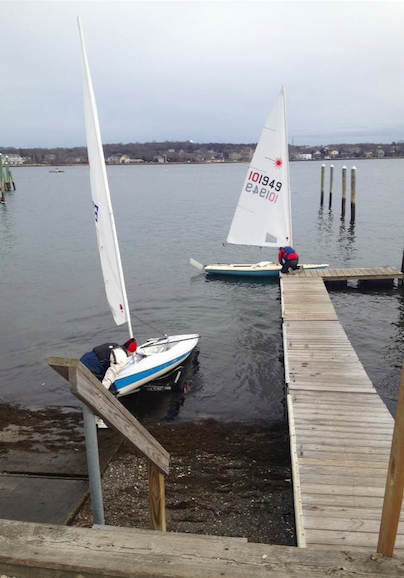
About the Author:
Paige Hoffman, Northeast/High School Sailing Airwaves Reporter

2017 DN World Championship Report & Results
On January 20th, 108 sailors from eleven different countries still had no idea where in the Western United states they would race the 2017 DN World Championship, set to begin in two days.
“Welcome to Iceboat racing!”
An unseasonably warm weather pattern overtook the Midwest and turned most of the frozen lakes in the region to mush a week before the event was set to begin. Most iceboaters pray for a late January rain, we call it the Great Zamboni, but nobody likes to see three days of rain and seven days of temperatures in the mid-forties before a big event. Warm rainwater creates huge holes in the ice and turns the surface into a slushy, wet mess. It’s the equivalent of racing F1 cars on sandy track littered with potholes big enough to pull off tires. DNs thrive in a frictionless environment, but when pushing through soft ice, things get real slow, real quick.
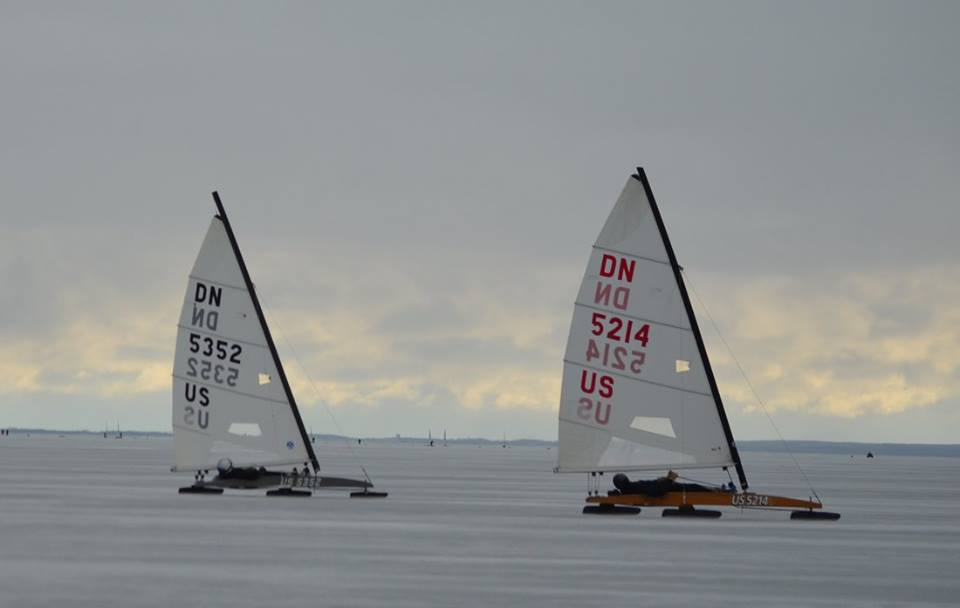
If you find yourself unfamiliar with the humble little DN (Detroit News), don’t worry. Most of the sailing community hangs up their sails for the winter and finds something warmer to do. For those of us that iceboat, we often find ourselves referring to summer racing as a way to pass time until we can get to ‘real’ sailing. The DN is a wooden, 12ft long, 100-150lb, DIY developmental class designed to hurtle a sailor around the ice at speeds up to 60mph (2-4 times the average windspeed). This community of competitors is filled with some of the most technically minded sailors in our sport. Names like Harken, Struble and Gougeon (West System Epoxy) permeate the sport’s history. Each home-built boat has its owner’s unique interpretation of go-fast techniques much like the Moth, 505 or A-class cat fleets. Sailors spend hours honing the runners (skates) to achieve optimum profile for the ever-changing ice condition. They constantly adjust settings to make the boat bend and respond to changing conditions. Unlike soft-water boats, where you can adjust most settings on the fly, DN racers only have a mainsheet and tiller once they leave the starting blocks. If the boat is set up too stiff it can be a wild ride, if you play it safe and sail the boat loose, you find yourself lacking enough power to keep up. It is without question the development-based culture of this design and thrill of the speeds that keeps sailors coming back year after year. Why else would somebody travel thousands of miles (from as far as Russia) to freeze their butts off on a frozen lake for a chance, and I stress the word chance, to get a couple races in?
The night of the 21st, sailors collected at a local DN racer’s business for a meet and greet, skippers meeting and the ceremonial singing of National Anthems. Sailors laughed and cheered as competitors sang their hearts out in a show of pride and community. It was refreshing to see such camaraderie between sailors from such vastly different cultures and communities.
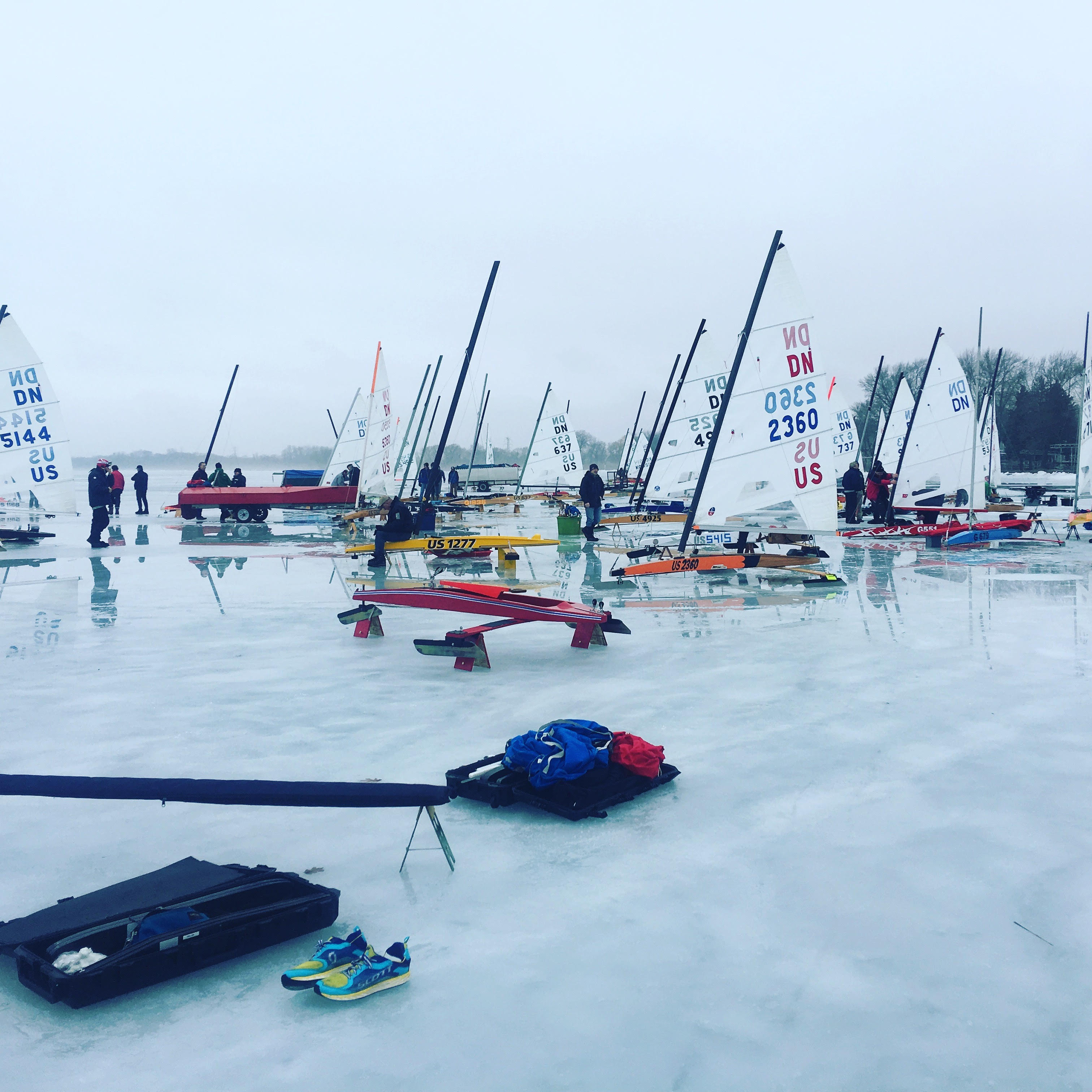
The first three races of the day were qualifiers for Gold, Silver and Bronze fleets. Those whi have a lower international rank have to sail hard to qualify for Gold fleet. After everyone is seeded the race officials initiate scored racing. The regatta is considered complete at three Gold races with no more than seven races per fleet to be sailed during the event. A forecast of light air and potential snow over the next three days meant that there was little time to fix boatspeed problem. Each sailor knew the winners could very well be decided by the end of the day.
The first race of the day was sailed in sub-optimal conditions for high speeds. In six knots of breeze the Gold fleet left the line for a three lap race in intense, challenging conditions. Those that spent the extra time with their alignment and runner selection immediately showed speed. Sailors that were able to sail around the slush (much like big waves) and keep the boat going were able to stretch their legs and extend. The rest of the fleet piled into the first mark as best they could but a huge, soggy patch at the windward mark made transitions to the downwind challenging. Boats that could carry speed through the turn would make gains on the downwind, those that tacked short of the layline paid a terrible price. Carol Jablonski, from Poland, was first around the windward mark and he never looked back. The ten time world champion put together the perfect picket fence and ended the day with a four point lead on Matt Struble. Silver fleet sailed in similar conditions, but the top sailors in each race swapped a significant amount more than was usual. A local sailor, Tim Sugar, was able to string together two wins in race three and four ending the day tied for first. Bronze fleet sailed most of their races in the lightest winds of the day splitting the fleet into those who could get top ten finishes and those who couldn’t. By the end of the third race, Chad Coberly held a three point lead on second place before the sun got too low to continue racing.
The second day of the event was forecasted to be quite light and in a rare show of skill, the weathermen were right. Sailors walked their boats out to the starting line and waited for any sniff of breeze to try new settings. A sucker puff would show up every hour or so and cause a flurry of movement, but by 3:30pm it became clear sunset was going to be the only event of the day. Sailors packed up and made the long walk back to the staging area, pushing or pulling their boats along. The fleet derigged in the pits and sailors walked around sharing beers and jokes. You can’t bring this fleet down.
The forecast for day three was punctuated by a thick coat of rain and snow, followed by more light air. During the night, Madison saw 4-6 inches of heavy snow as the fat lady belted out her best. There would be no suitable lake in the Madison area and little possibility of race-worthy ice in the greater Midwest. Event organizers sent racers to several different lakes on the outskirts of the weather system to test sail whatever they could find. Meanwhile, competitors packed up and traded stories at a local bar that became the event’s unofficial home base. By mid-day, it was clear that no lake within one day of travel was suitable for further racing and it was announced that the 2017 DN World Championships was concluded. Not one person expressed dissatisfaction and you could see, it was smiles all around. The heart of an iceboater hopes for the best but accepts the worst. Each race sailed was fair and well-run; the fleet was happy.
Congratulations to Carol Jablonski for winning Gold Fleet for the 11th Time, Tim Sugar for 1st place in Silver fleet and Chad Coberly for a convincing win in Bronze Fleet. Full results HERE
Two days later the same fleet of sailors, including most of the international competitors, descended on Peshtigo, Wisconsin to do it all again for the 2017 DN North American’s. Nothing can crush the spirits of these sailors. The ride is too good, the community is too strong and there is always better ice around the corner.
Results, pictures, video and more information on the Class or event can be found on the DN North America website NA.IDNIYRA.org
Club Profile: James Island Yacht Club
By Airwaves writer Taylor Penwell Brought to you by: SELDEN & KO SAILING

The club started as part of an agriculture society in 1895 and raced their sailboats against other surrounding islands in the Charleston area. The club was officially incorporated in 1905. The club has an equal share of sailors, powerboat enthusiasts and fishermen. With Charleston becoming such a popular moving destination the JIYC has seen a large influx of membership applications, which is always a good sign for a club.
The many great activities at the JIYC include fantastic sailing with regular year round racing, a summer junior sailing program, fishing clubs and tournaments, and community charities. There is a playground for children, mutual use grills, small beach area for relaxing and launching boats, and of course a bar that is open year round.
The sailing race scene is competitive with many highly awarded sailors calling the club their home. Racing includes PHRF, a frostbite series for Laser, a summer Sunfish series every Tuesday that can get 20-30 boats, along with Lightings and Thistles. The club has one of the biggest groups of foiling Moth sailors in the country. The Moth class association has held their North Americans, Nationals and other large events at the JIYC. In 2014, member Ned Goss set the world Moth speed record at 35.9 knots. Award winning club members consist of a three time Sunfish World Champion, a sailor with 28 National and World titles in five different boats, and other 
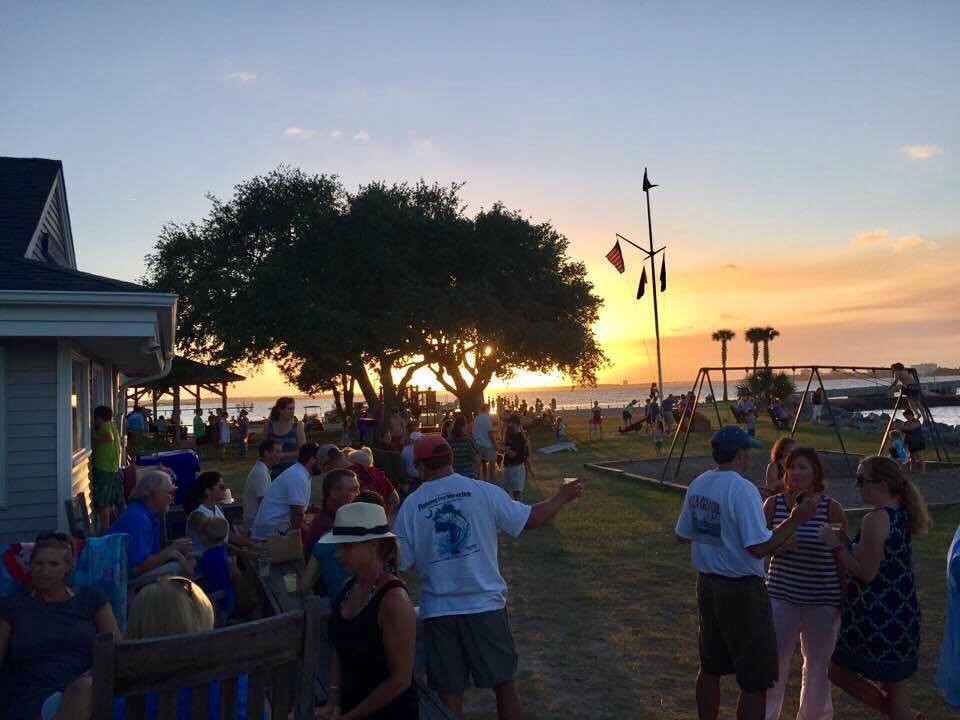
Click here more information of the James Island Yacht Club,
http://www.jiyc.org/
A special thanks to James Island Yacht Club member and friend Ryan Hamm for supplying information on this great club.
